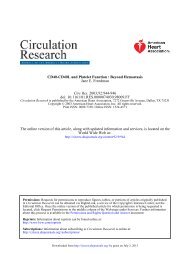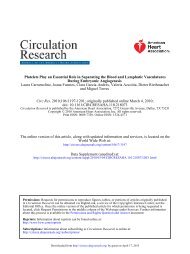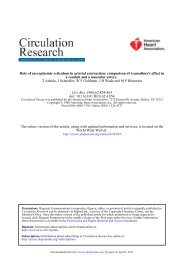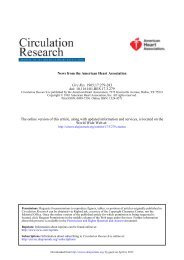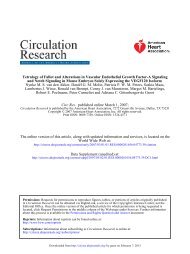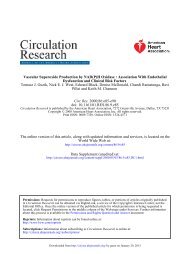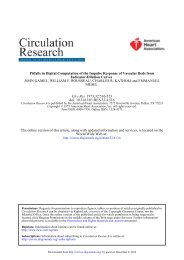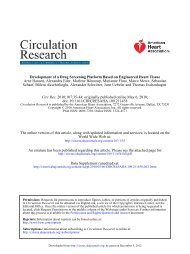RICHARD V. EBERT, CRAIG W. BORDEN, WENDELL H. HALL and ...
RICHARD V. EBERT, CRAIG W. BORDEN, WENDELL H. HALL and ...
RICHARD V. EBERT, CRAIG W. BORDEN, WENDELL H. HALL and ...
You also want an ePaper? Increase the reach of your titles
YUMPU automatically turns print PDFs into web optimized ePapers that Google loves.
382 SHOCK DUE TO BACTERIAL TOXIN<br />
of interest because of the relationship of<br />
acute circulatory failure in meningococcemia<br />
in human beings to massive adrenal hemorrhage.<br />
The combination of meningococcemia,<br />
shock <strong>and</strong> adrenal hemorrhage has been<br />
called the Waterhouse-Friderichsen syndrome.<br />
It has been postulated that the circulatory<br />
failure is caused by adrenal insufficiency.<br />
This has been denied by other authors 8 who<br />
have pointed out that acute circulatory failure<br />
occurs in the absence of massive adrenal hemorrhage.<br />
In these animals massive adrenal<br />
hemorrhages were not seen. The ineffectiveness<br />
of cortisone would suggest that adrenal insufficiency<br />
was not playing an important role<br />
in the production of circulatory failure following<br />
the administration of meningococcus toxin.<br />
DISCUSSIOX<br />
The hemodynamic effects of meningococcus<br />
toxin can best be explained by an increase in<br />
volume of blood in peripheral vessels. The<br />
resulting diminution in venous return would<br />
account for the fall in right atrial <strong>and</strong> pulmonary<br />
vascular pressures <strong>and</strong> the decrease<br />
in cardiac output in the presence of a normal<br />
total blood volume. This mechanism appears<br />
to be the basic factor incuding hypotension<br />
following administration of toxin. The critical<br />
effect of changes in blood volume is also<br />
compatible with this hypothesis. Diminution<br />
in blood volume by a small hemorrhage caused<br />
further decline in cardiac output <strong>and</strong> arterial<br />
pressure. Increase of blood volume above<br />
normal by dextran infusion raised the right<br />
atrial pressure to normal or increased levels,<br />
<strong>and</strong> led to a marked increase in cardiac output.<br />
The arterial pressure also increased but to a<br />
lesser extent.<br />
Lack of conclusive directional change or<br />
actual increase of the calculated T.P.R. following<br />
administration of toxin suggests that there<br />
was little change in resistance to flow at the<br />
level of the arterioles. This is based on the<br />
assumption that the arterioles contribute the<br />
majority of the resistance reflected by the<br />
calculated T.P.R. As emphasized by Green<br />
<strong>and</strong> co-workers, 8 interpretations of changes in<br />
vascular tonus based upon calculations of<br />
T.P.R. should be made cautiously. Alterations<br />
of cell plasma ratio <strong>and</strong> of blood flow will<br />
influence the effective viscosity of the blood.<br />
Changes in intravascular pressures will produce<br />
passive changes in the size of the vessels.<br />
It appears unlikely that the contribution of<br />
these factors to the observed changes is of<br />
sufficient importance to alter the main implications<br />
of the data.<br />
The basic mechanisms bj r which meningococcus<br />
toxin produces its effect on the circulation<br />
is unknown. Two possibilities may be<br />
considered. The toxin may alter the elastic<br />
properties of small vessels permitting them to<br />
distend more completely at a given pressure.<br />
This effect could be mediated through direct<br />
damage to vascular endothelium or musculature<br />
or indirectly through humoral, metabolic,<br />
or nervous mechanisms. A second, <strong>and</strong> more<br />
remote, possibility is that the toxin has no<br />
effect on the elastic properties of small vessels<br />
but induces active venoconstriction with subsequent<br />
rise of pressure <strong>and</strong> distention of<br />
distal small vessels. In regard to the above<br />
possibilities, the following observations are of<br />
interest. Bacterial toxins have been observed<br />
to produce hemorrhage <strong>and</strong> necrosis in<br />
tumors. 10 Direct observations of the effect<br />
of the polysaccharide derived from Serralia<br />
marcescens on tumor tissue <strong>and</strong> normal muscle<br />
have been made. 11 Slowing of the arterial <strong>and</strong><br />
venous circulation with capillary stasis<br />
occurred. Meningococcus toxin as well as<br />
products from other bacteria produce the<br />
Shwartzman phenomenon. Thomas 7 has observed<br />
cortical necrosis of the kidneys of<br />
rabbits following repeated injection of<br />
meningococcus toxin. These observations suggest<br />
a profound effect of bacterial toxins on<br />
the small vessels.<br />
The effect of meningococcus toxin on the<br />
circulation is similar to the effect of the toxin<br />
of Clostridium oedematiens. In the experiments<br />
of Aub, Zamecnik <strong>and</strong> Nathanson a marked<br />
fall in arterial pressure <strong>and</strong> cardiac output<br />
followed the injection of the toxin of Clostridium<br />
oedemalien8. n There was only a slight<br />
decrease in blood volume. Increase in blood<br />
volume by transfusion with blood or albumin<br />
Downloaded from<br />
http://circres.ahajournals.org/ by guest on November 28, 2012




